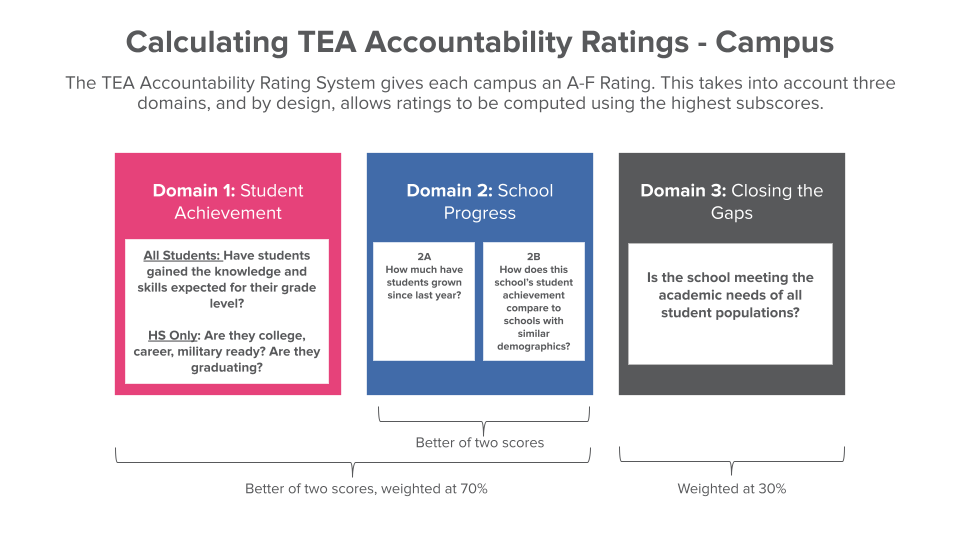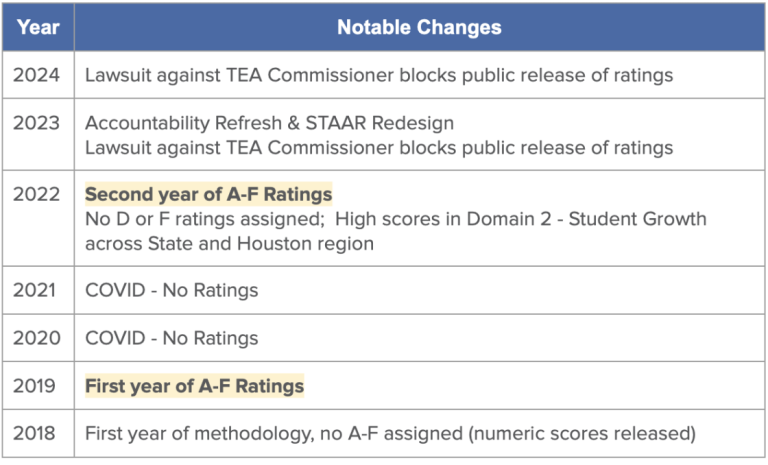Dear Partner,
This month’s Houston ConnectEd is taking a bit of a detour from our usual dive into quantitative data and trends in numbers. Instead, we’re focusing on the impact of missing data, especially after the Texas Education Agency’s A-F Accountability ratings were blocked from release earlier this month. We’ll give you a quick rundown of the A-F system over the past five years, what this means for our city, and highlight some resources that are making data more accessible to Houstonians.
But don’t worry, data enthusiasts – we’ve got plenty of numbers coming your way. Last month, Good Reason Houston took a closer look at equity gaps in STAAR performance with the July release of Preliminary STAAR results. The Texas Education Agency is set to release the final data at the end of August, and we’ll keep updating our dashboards and sharing exclusive analysis.
If you have any questions or thoughts about what we’re covering, feel free to drop us a line at info@goodreasonhouston.org, or connect with us on social media using #HTXConnectEd.
Sincerely,

In this email, we’ll provide you with:
Texas Accountability Background | Data Resources | Data in the News
The Gist:
The Gist provides key takeaways from this month’s Houston ConnectEd. Read on for more detail on what the data is telling us about the state of public education.
- The TEA Accountability Ratings were blocked from release by a Judge after several districts filed a lawsuit against the Agency in August. This will be the fourth year since 2019 where ratings were not released to the public. The ratings not being released consistently has made it difficult to get a snapshot of school quality.
- Several districts across the State are sharing their results publicly, including Houston ISD which showed strong results.
- There is a wealth of information that helps us understand how schools are doing and Good Reason Houston will continue to provide resources that make sense of student achievement and outcomes across our city.
2024 Accountability Ratings Blocked
On August 12, a Travis County Judge blocked the planned release of Texas Education Agency’s (TEA) A-F Accountability Ratings. The order is part of a new lawsuit brought on by five Independent School Districts against the Commissioner. The suit argues that the redesigned STAAR test and its use of artificial intelligence to score written responses invalidates the test results.
Accountability Ratings are based largely on students’ STAAR performance and year-over-year growth, in addition to measures like graduation rates, College Career, and Military Readiness (CCMR), and equity gaps across several indicators.

A Brief Timeline of Ratings Since 2019
If the court continues to block the ratings, this will be the fourth year with no Accountability data since 2019. In 2020 and 2021, ratings were not released due to the COVID-19 pandemic and its major impact on school. Districts across the state did not administer STAAR in 2020 and testing in 2021 was optional.
Accountability data was released in Fall 2022, reflecting the first full year of in-person learning since the pandemic. Across the Houston region, we saw more than 508,000 students attending 618 A- or B-rated schools. There were several notable irregularities in this release, including:
- High Growth Across The Region: Due in part to historically low STAAR performance in 2021, most campuses saw extremely high year-over-year student growth in 2022. TEA’s rating calculation automatically takes the higher of Domain 1 and Domain 2 in generating campus and district overall scores. In 2022, 74% of campuses in Houston relied on the growth component of Domain 2 to calculate their rating, compared to only 22% in 2019. Our 2022 A-F dashboard visualizes this trend.
- No A-F Assigned for Campuses Scoring in the D and F Range: Senate Bill 1365 stipulated that 2022 ratings would not assign a letter grade to campuses scoring below 70%. Instead, these campuses would receive a “NR: SB 1365” designation. In addition to withholding their letter grade, these campuses would be exempt from an “Improvement Required” designation, breaking multi-year chains of low performance that may otherwise lead to state intervention.
TEA Accountability Ratings in 2023 were also subject to major changes and resulted in a lawsuit blocking their release. The STAAR was redesigned in the 22-23 school year, shifting to a computer-based administration, adding open-ended and written components, and including cross-curricular passages that better assess students’ mastery of Texas Essential Knowledge and Skills (TEKS). In addition, the Commissioner, as required by state law, made changes to the Accountability Ratings methodology. These changes prompted a lawsuit against the Commissioner alleging that the changes were not made transparent. Last year’s temporary injunction on the ratings has not yet been lifted.

The Accountability Rating System is one of many important pieces of data that helps our community understand the state of schools in our city with a focus on student achievement. The A-F designation helps give an easy-to-understand assessment of how schools and districts are driving student learning, taking into account school and district demographics and progress for historically disadvantaged student groups. Ratings can and should be used by district leaders to make decisions on how to allocate resources and deploy supports to the highest need students and schools. They also help our community identify bright spots and inspire bold action to improve student achievement and outcomes, and provide transparency on the state of schools.
At the same time, districts gather data across multiple assessments of student achievement and our team supports several partnering districts in using this data to make strategic decisions. In addition to the robust insight provided by the current accountability system, we explore measures such as enrollment, staff demographics and retention, specialty programs, and parent and student surveys to learn how schools and districts are serving every child.
Additional Data Resources
There is a wealth of data that we as a community can use to understand the current state, progress, and areas of improvement for our public schools. Good Reason Houston’s Research and Data team continually gathers and analyzes publicly available data to shed light on bright spots and to improve access to information.
- Our Public Education Snapshot includes data across four key indicators: Pre-K Enrollment, Student Achievement, CCMR, and Postsecondary Completion. The snapshot is being updated for 2024, which we’re excited to unveil in October. In the meantime, we’re sharing the most recent data here.
- We host a monthly webinar to help share information on current data and future trends. This month, we partnered with Dr. Rayan Amine from Alief ISD to address several myths about Accountability.
- Our STAAR Preliminary Dashboard pulls together STAAR performance for all campuses and districts in Good Reason Houston’s defined geography. The dashboard includes final data from 2014-2023 and preliminary data from 2024 that was released earlier this summer.
Data in the News
Here are some of the education-data news items we’ve been keeping our eye on over the past few weeks.
- Houston ISD Shares Campus A-F Ratings – Despite TEA once again being blocked from releasing official A-F accountability ratings for the 2023-2024 school year, the agency sent districts the data and methodology needed to calculate ratings themselves. HISD’s internal calculations found that the number of campuses projected to receive A or B ratings nearly doubled from 2023 to 2024, now accounting for well over half of the district’s schools. Meanwhile, the number of campuses receiving D or F ratings is estimated to have fallen from nearly half of schools in 2023 to only 16% in 2024. Other districts have followed HISD’s lead in announcing their internal calculations of school ratings in response to the continued delays to the state releasing official ratings.
- Houston ISD shares real-time enrollment dashboard – HISD recently launched a public dashboard tracking enrollment trends for the start of the school year. Although the dashboard is no longer active, it showed that by the fourth day of school, the district had about 9,000 fewer students compared to the same day last year, with just over 170,000 students enrolled. Note that “membership” counts students receiving daily instruction from the district, while “enrollment” includes students who may receive services from the district but attend other schools. The official membership count will be finalized by October 25, with last year’s number at around 184,000. The earlier start to this school year might be affecting the current numbers.
- Statewide TELPAS scores have been low for six years, following a test redesign – TELPAS, the test for assessing English proficiency in Texas, saw a significant scoring change six years ago, leading to a drop in scores that hasn’t recovered. Some experts think the scoring shift, not a decline in students’ English skills, is responsible for the lower scores. For emergent bilingual (EB) students, achieving high TELPAS scores is crucial for reclassification into regular programs. Research from the Houston Education Research Consortium shows that EB students who don’t reclassify by elementary school are less likely to succeed academically and face higher rates of absenteeism and disciplinary issues later on.




